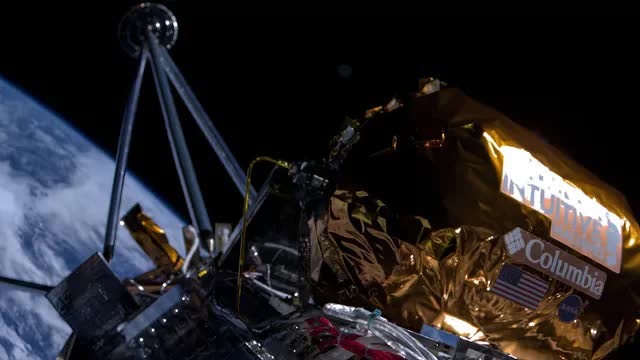05:58:25 pm 02/23/2024
Viewed: 7507
The Dawn of a New Lunar Exploration Era: U.S. Returns to the Moon
The United States has embarked on a monumental journey, marking its first lunar landing since the Apollo missions ended in 1972. This new chapter in space exploration has been heralded by the successful touchdown of the Odysseus spacecraft, developed by Houston-based Intuitive Machines, and the unveiling of the Peregrine lander by Astrobotic Technology Inc. These milestones signify a renewed interest and commitment to lunar exploration, showcasing the pivotal role of private companies in leading the charge towards the next frontier.
Astrobotic's Peregrine Lander: Paving the Way
Astrobotic Technology Inc., a Pittsburgh-based company, has been at the forefront of this new lunar expedition. The company's Peregrine lander, described as resembling an upside-down pot, is designed to carry up to 100 kilograms (approximately 220 pounds on Earth) of payloads to the moon's surface. With a cost of $1.2 million per kilogram for payload delivery, Peregrine represents a cost-effective solution for space exploration, compared to traditional rocket launches. The mission, launched aboard a United Launch Alliance (ULA) Vulcan Centaur rocket, carries up to 28 payloads from eight different countries, including the United States and Mexico, highlighting the global interest in lunar exploration
.
Astrobotic was among nine companies selected to compete for a share of $2.6 billion, aimed at developing small space vehicles and technology for 20 missions to explore the lunar surface over the next decade. This initiative is part of a broader strategy by NASA to outsource space activities to private companies, aiming to make NASA one customer among many in the low-Earth and lunar marketplaces
.
A Historic Milestone: Odysseus' Successful Landing
The Odysseus spacecraft's successful landing on the moon by Intuitive Machines is a testament to the advancements in space technology and the growing role of private enterprises in space exploration. This achievement not only marks the first U.S. spacecraft to land on the moon since the Apollo program but also highlights the competitive spirit among space companies like SpaceX, Blue Origin, and others, driving innovation and reducing costs in space exploration.
The Broader Vision: Renewed Interest in the Lunar Surface
The successful missions of Peregrine and Odysseus underscore a renewed interest in the moon, not just as a destination but as a stepping stone for future space exploration. These missions carry technology and experiments that will lay the groundwork for astronaut trips by 2024, under the ambitious schedule laid out by the Trump administration. Beyond the immediate scientific and exploratory benefits, these missions represent humanity's enduring spirit of discovery and our quest to explore the unknown.
Looking Ahead: The Future of Lunar Exploration
The return to the moon is just the beginning. With plans for more missions, including human landings, the moon could serve as a critical launchpad for missions deeper into space, including Mars. The involvement of private companies, through partnerships with NASA and international collaborators, is creating a new ecosystem for space exploration, one that promises to be more sustainable, cost-effective, and innovative.
As we witness these historic moments, we are reminded of the limitless possibilities that space exploration holds for the future of humanity. The journey back to the moon is not just a series of missions; it's a symbol of our collective ambition to reach beyond our grasp and explore the cosmos. The dawn of this new lunar exploration era is upon us, and with it, the promise of discoveries that could change the course of human history.
The recent accomplishments in lunar exploration by Astrobotic Technology Inc. and Intuitive Machines, supported by NASA's vision and international collaboration, herald a new era of space exploration. As we continue to push the boundaries of what's possible, the moon once again captures our imagination and beckons us to dream big, reminding us that the sky is not the limit, but just the beginning.
The United States has embarked on a monumental journey, marking its first lunar landing since the Apollo missions ended in 1972. This new chapter in space exploration has been heralded by the successful touchdown of the Odysseus spacecraft, developed by Houston-based Intuitive Machines, and the unveiling of the Peregrine lander by Astrobotic Technology Inc. These milestones signify a renewed interest and commitment to lunar exploration, showcasing the pivotal role of private companies in leading the charge towards the next frontier.
Astrobotic's Peregrine Lander: Paving the Way
Astrobotic Technology Inc., a Pittsburgh-based company, has been at the forefront of this new lunar expedition. The company's Peregrine lander, described as resembling an upside-down pot, is designed to carry up to 100 kilograms (approximately 220 pounds on Earth) of payloads to the moon's surface. With a cost of $1.2 million per kilogram for payload delivery, Peregrine represents a cost-effective solution for space exploration, compared to traditional rocket launches. The mission, launched aboard a United Launch Alliance (ULA) Vulcan Centaur rocket, carries up to 28 payloads from eight different countries, including the United States and Mexico, highlighting the global interest in lunar exploration
.
Astrobotic was among nine companies selected to compete for a share of $2.6 billion, aimed at developing small space vehicles and technology for 20 missions to explore the lunar surface over the next decade. This initiative is part of a broader strategy by NASA to outsource space activities to private companies, aiming to make NASA one customer among many in the low-Earth and lunar marketplaces
.
A Historic Milestone: Odysseus' Successful Landing
The Odysseus spacecraft's successful landing on the moon by Intuitive Machines is a testament to the advancements in space technology and the growing role of private enterprises in space exploration. This achievement not only marks the first U.S. spacecraft to land on the moon since the Apollo program but also highlights the competitive spirit among space companies like SpaceX, Blue Origin, and others, driving innovation and reducing costs in space exploration.
The Broader Vision: Renewed Interest in the Lunar Surface
The successful missions of Peregrine and Odysseus underscore a renewed interest in the moon, not just as a destination but as a stepping stone for future space exploration. These missions carry technology and experiments that will lay the groundwork for astronaut trips by 2024, under the ambitious schedule laid out by the Trump administration. Beyond the immediate scientific and exploratory benefits, these missions represent humanity's enduring spirit of discovery and our quest to explore the unknown.
Looking Ahead: The Future of Lunar Exploration
The return to the moon is just the beginning. With plans for more missions, including human landings, the moon could serve as a critical launchpad for missions deeper into space, including Mars. The involvement of private companies, through partnerships with NASA and international collaborators, is creating a new ecosystem for space exploration, one that promises to be more sustainable, cost-effective, and innovative.
As we witness these historic moments, we are reminded of the limitless possibilities that space exploration holds for the future of humanity. The journey back to the moon is not just a series of missions; it's a symbol of our collective ambition to reach beyond our grasp and explore the cosmos. The dawn of this new lunar exploration era is upon us, and with it, the promise of discoveries that could change the course of human history.
The recent accomplishments in lunar exploration by Astrobotic Technology Inc. and Intuitive Machines, supported by NASA's vision and international collaboration, herald a new era of space exploration. As we continue to push the boundaries of what's possible, the moon once again captures our imagination and beckons us to dream big, reminding us that the sky is not the limit, but just the beginning.
No video exists.





Comments